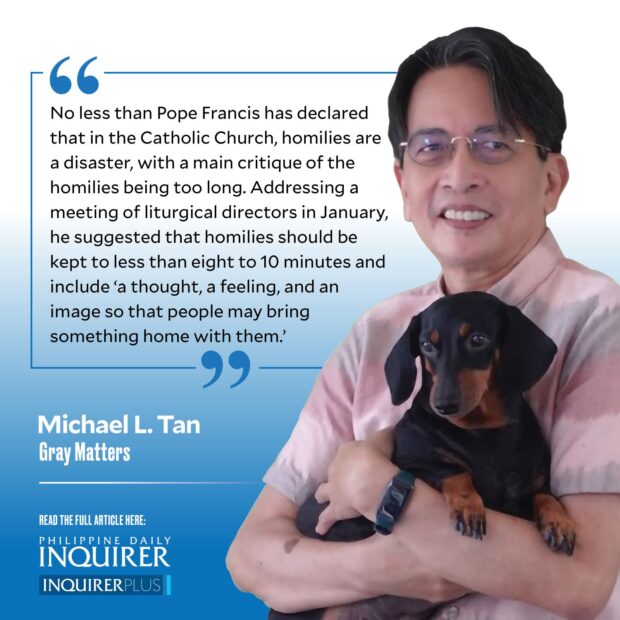
In conversational English, we tend to interchange sermons and homilies, but technically there’s a difference between the two. Sermons are meant as lectures and religious instructions to inculcate moral behavior while homilies are more informal and conversational, a commentary that follows the readings of the Epistles and the Gospel.
Specifically addressing his audience of liturgical directors, Pope Francis refers to the danger of “beautiful rituals but without vigor, without flavor, without sense, because they do not touch the heart and the existence of the people of God.”
In the Philippines, we see that lack of vigor and flavor and sense with people dozing off or others leaving the church to smoke, chat, do some quick shopping (if the Mass is in the mall), or even flirt.
But I’ve wondered if the problem is just long sermons. The American group Pew Research Center, which specializes in research on religion, found in a 2019 survey in the US that among the different church groups, Catholics were at the bottom in terms of churchgoers being somewhat or very satisfied with the sermons. Evangelical Protestants topped the list with 93 percent satisfaction, followed by mainline (the more liberal Protestants) sects with 91 percent satisfaction and Catholics with 83 percent.
Yet, the median length of sermons was found to be the shortest with Catholics at 14 minutes, 25 minutes for mainline Protestants, and 39 minutes for evangelical Protestants, a totally inverse relationship.
No doubt, the “too long” complaint is probably the most common negative evaluation of sermons and homilies but people will tolerate, even enjoy, long sermons if the content and style are good.
The Pew Research Center’s study that I just described used computational analysis to look at the most common words used in nearly 50,000 sermons from different church groups’ sermons and found that evangelical churches’ most frequent words were “eternal … hell,” “lose … salvation,” “trespass … sin,” “home … heaven,” “Bible … morning.” Mainline Protestant churches’ most frequent words were “united Methodist,” “always … poor,” “how … Thomas,” “gospel … lesson.” Finally, Catholic sermons’ most frequent words were “homily, diocese, Eucharist, paschal, parishioner.”
Hello, hello, are you still there, readers?
Catholic sermons do tend to use bland, abstract words, losing out on grabbing the “ecclesial moment” to preach the “Good News” of the bible. (Even if its “flavor” tends to be too much of threats of hellfire.)
I would love to see local studies on what a good sermon or homily would be. Certainly, sermon has become a Filipino word, including being used to refer to being scolded by elders.
If sermons and homilies sometimes end up too long, it’s because priests sometimes want to be more conversational and do then end up rambling, even gossiping.
Then there are priests who end up like stand-up comedians, joke after joke after joke, which can be disastrous, too.
A gauge of good sermons or homilies would be whether they can be collected, published, and bought. Former Ateneo president Fr. Jose Ramon Villarin has several anthologies—“Startle: Gathering Light from the Word of God,” “Weeded: Listening for God’s Word to a Messy World” and “Siya Nga!” All three are touted as reflections on the Gospels and “Siya Nga!” using artwork and reflections.
I’m sure you’ve sometimes felt you’re trapped in church forced to listen to a bad sermon or homily, so think of the times when you do have control over the sermon, for yourself and friends. This is for weddings and memorial Masses for the deceased. It’s important to find a priest who you and/or your family know well and who will deliver that much-needed homily that comforts and strengthens rather than just babbling away with inappropriate jokes.
Since this is Lent, may I appeal to our good priests to make sure their sermons during the season do not themselves become penitence!
mtan@inquirer.com.ph